Genre: Educational Developer: Western Tech. Inc. Publisher: Davidson & Associates Players: 1 Released: 1994
When I was still in grade school, I loved to make up reasons that allowed me to play more video games. (I kid, of course. I still did that all the way through my college years and beyond). My parents, of course, weren’t all that thrilled about that. I should do my homework, not play on my computer all the time. That’s why there are edutainment games out there: Titles in that particular genre claim to make learning fun, teaching children particulars of a certain subject matter while they play their favorite console or home computer. Naturally, my parents tried that approach and occasionally got me a learning program or teaching game for my Amiga home computer. Sometimes it worked – I always liked Where in the World is Carmen Sandiego?, for example. Most of the time though, these games had one inherent problem: they sucked! Many programmers of so-called edutainment games didn’t seem to grasp that a game should also have entertaining gameplay.
But maybe the games themselves aren’t really to blame here, are they? Looking back on things, I kind of wondered: was it that I really didn’t like the game? Or did I just react badly upon hearing the word “learning?” Was it because my parents never understood the fun I had in gaming, and thus didn’t really grasp how to get me interested in the subject matter? If they had sat beside me, and played with me, would I eventually have come to like more of these games? And furthermore, how much is there really to learn this way anyway?
Hindsight is always a little problematic. At any rate, I’m not a kid anymore (a child at heart, at best). But luckily, I now have a little niece that is currently in third class in grade school. Furthermore, my nieces consider me to be the “fun uncle,” since I’m the only one in my family to own and still play video game consoles. So, I decided to do a little experiment. Upon learning that there was a math learning/shooting title out there called Math Blaster, I took my niece aside and tried playing that game with her together. It’s also available for SNES and PC, but it was easier for me to get hold of the Genesis version, and since this site is called Sega-16, I opted for that console port. My niece does alright in math, but doesn’t like doing homework all that much, so it seemed like the perfect opportunity to try this. Besides, how bad could it possibly be?
Insert ominous thunderclap sound here.
So anyway, the game. There’s a little backstory about what’s going on here. Our little alien pal Spot has been kidnapped by the malicious Trash Alien, an ugly fella who likes to litter wherever he goes (trying to sneak a little environmental message in here as well game producers, aren’t we?). Our hero, the Blasternaut, sets out to search for his friend, and thus we get the title of this game. The original PC version split the chase over four different chapters, each with a different minigame that centered around solving math problems. One of these stages (the “Number Recycler”) was cut from the Genesis version however, making an already rather short game even shorter.
Before starting the game, the user can set several starting parameters. You can set the number of Blasternauts (or “lives”) from three to five. “Math difficulty” determines not only how hard the exercises are, but also the type of arithmetic you’ll engage in: 1-3 covers addition, 4-6 subtraction, 7-9 multiplication and 10-12 division. Also worthy of note is the “game difficulty” option. Basically, this switch determines whether the player will be attacked by other hazards in addition to solving math problems or not.
The first stage is the “Trash Zapper.” Here, the player’s character is placed behind a viewscreen, watching various pieces of trash passing by, each with a certain number assigned to it. The game then asks a series of math problems (for example “4+5=?”), upon which the corresponding object has to be targeted and … well, zapped. Get the wrong answer, and your energy is drained. Run out of energy, and you lose a life. This successfully discourages kids from just wildly zapping everything on screen until they reach the next wave. To keep things from getting boring (and if you set the game to normal difficulty), every once in a while, an enemy spaceship appears to fire at you, so you either need to shoot it down quickly first or use up a bit of your limited amount of shield energy do deflect the attack. This stage comes in three waves and is interrupted by bonus stages, where the player gets to freely shoot down space debris and vent a little before going back to solving math problems. In principle, this segment isn’t a bad idea. The alien attacks keep things from getting too boring, and the bonus stages, while graphically simplistic, are enjoyably cathartic somehow. The various pieces of trash range from Cola cans to combs, crumpled paper and even slices of pizza for some reason – I found this weird, but my niece thought it was kind of funny, so no issues there.
Unfortunately, the controls are a bit problematic. The damage areas are a bit off, so quite often both me and my niece missed although we could have sworn that we had the target in our sights. Also, the trash objects flying around often overlap; take a shot at an inopportune moment and you end up zapping the wrong piece. Finally, the cursor moves way too slow. I still have the enraged shriek of my niece in my ear when she couldn’t reach the attacking alien vessel in time because it had appeared on the far side of the scream. (You know how seven-year-olds can scream? Then imaging what my ears felt like). Then again, you can use your shields for that, so it kind of balances out – but not quite.
On to the second stage, “Cave Runner.” This level had me stumped at first, and I needed to consult the instructions before we grasped what we needed to do here. The goal is to get to the top of a cave by jet pack. However, the passages are blocked by energy fields. To the left and the right of an open area are numbers or math equations (for example “7” and “9+2”). There’s also a number on the back of your Blasternauts. Drops falling from the ceiling, carrying terms like “-2” or “+10”, can raise or lower said number. What you need to do here is get the number on Blasternaut to equate something BETWEEN those on each side of the barrier before he can safely pass through. On normal difficulty, there are also small critters scurrying about that could hurt you, so additional zapping is in order. This stage is pretty nice – as any kid age six or older knows, jet packs are cool! Again, though there are some issues with the controls here, as they are too loose. It’s very easy to overshoot your target, and you frustratingly often successfully pass one barrier only to directly be zapped by the next one, or accidentally ending up in a critter you couldn’t see before. So, you need to be careful, or at least be a gamer experienced enough to deal with such finicky controls.
It was also during the “Cave Runner” stage when we encountered a little bug in the game. If you managed to pass the “Trash Zapper” segment with the minimum amount of energy left, you still get to see the opening cut scene of the next level. Upon starting the stage though, the Blasternaut immediately keels over and loses a life. If it was your last, it’s game over. Needless to say, both my niece and I were quite surprised when it happened (Or, to quote my niece: “that’s not fair!”)
Finally, there is the “Math Blaster” stage. Here you need to take down the alien spaceship by flying into the chute with the right answer to the math problem presented on top of the screen. Flying trash (which can be vaporized by shooting at it) is blocking the way. Also there’s a time limit of sorts. As the star in the background is nearing an eclipse, the alien charges its weapons. On a full eclipse, he fires, upon which the player instantly loses a life. This level also has three waves, each with a tighter time limit and more debris flying around. The last stage in particular can be a tad frustrating, as it really is quite challenging to avoid all the trash and hit the right tube on time without losing too much energy. Then again, the final challenge should be the hardest, so I guess it balances out somewhat.
As a final verdict, I admit I’m a bit torn in my decision. On the one hand, I can see the potential fun in this game. Rather than being forced to solve math problems in order to get to the next game, solving the equations is part of the gameplay, and integrated quite well. Furthermore, the level of challenge is okay, and aside from the little bug I mentioned it was neither unfairly tough nor too easy. On the other hand, the controls could definitely be better, especially in the very first segment. Losing energy due to handling issues is always a big no-go. Also, with only three levels to it the game is a bit too short and could have used some more variety. Both issues can be attributed to the transition from PCs to consoles (the DOS version also allows you to directly pick one mini-game, which you can’t do in this port). In the end, the Genesis version failed to hold my niece’s interest on its own. So, if you consider picking up this game for your kid, I suggest skipping the console ports and getting the computer edition instead. That seems to be the far better option, both entertainment and learning-wise.
SCORE: 4 out of 10

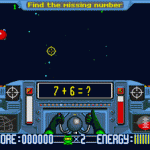
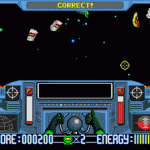
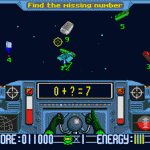
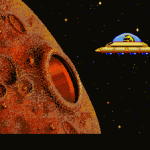
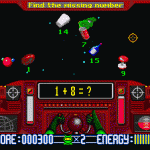
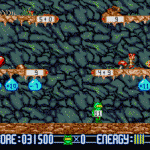
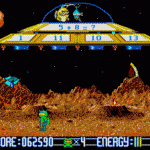
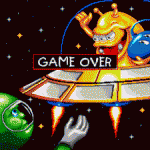
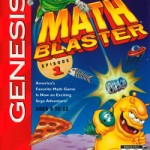
Recent Comments